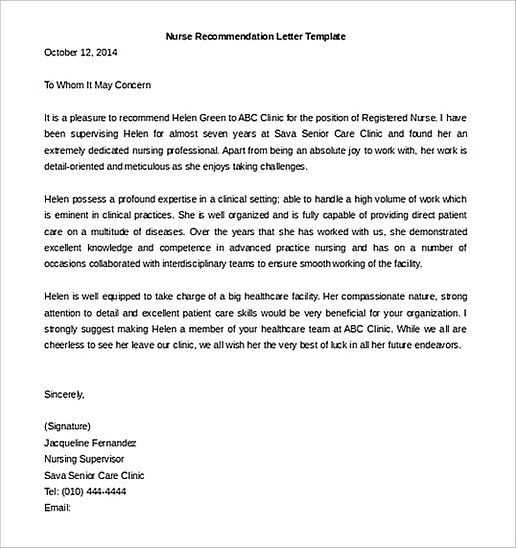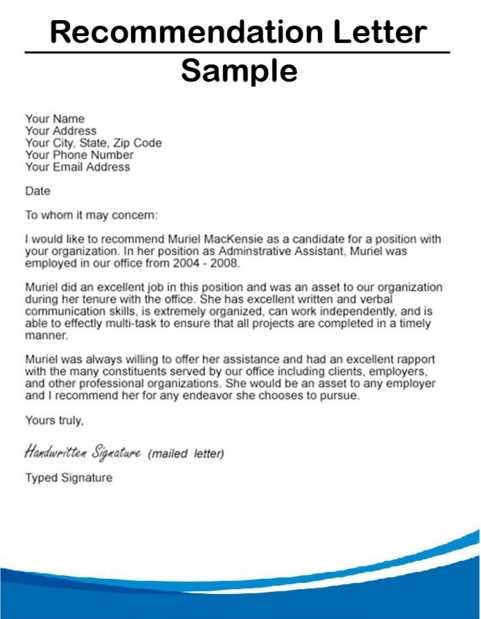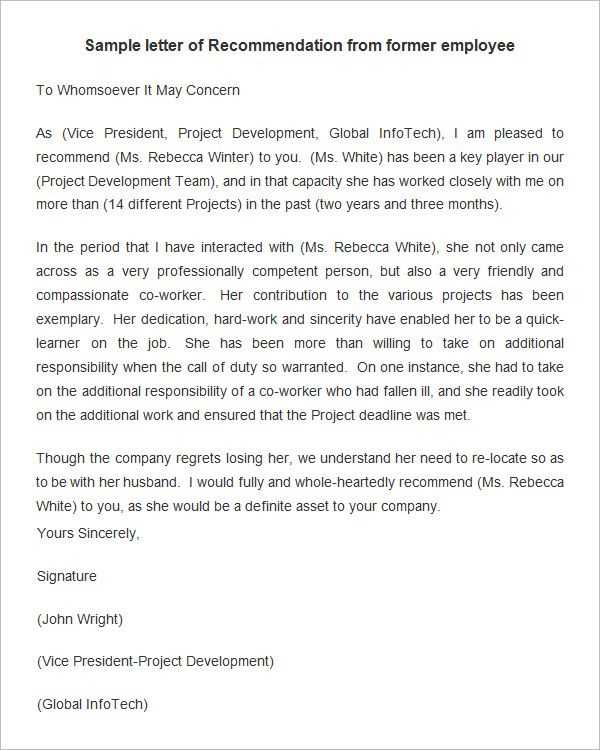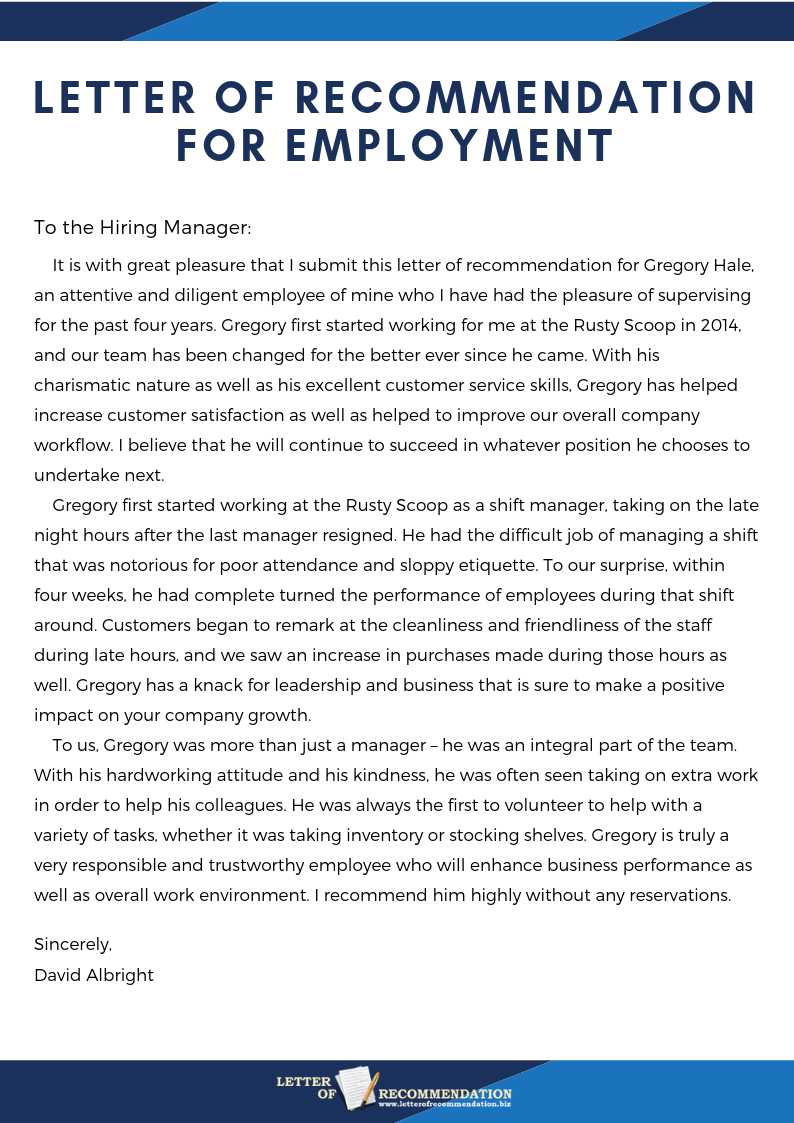Work letter of recommendation template

To create a standout work letter of recommendation, start by clearly stating the purpose of the letter in the opening paragraph. Include the full name of the individual being recommended, their role in your company, and the specific nature of your professional relationship. It’s important to express your confidence in their abilities right away. Use direct language, avoiding vague descriptions. For example, rather than saying “they were good at their job,” provide clear examples of tasks they excelled in.
Follow up with details of the individual’s accomplishments. Highlight any specific skills or projects they handled that had measurable outcomes. This part should focus on real contributions the individual made, such as improving team efficiency, contributing to a successful project, or taking initiative in solving complex problems. Mentioning quantifiable results, like “increased sales by 20%” or “reduced process time by 15%, ” adds weight to your recommendation.
Finish the letter by offering a strong, unambiguous endorsement. Acknowledge the person’s personal attributes that set them apart, such as their work ethic, leadership abilities, or teamwork skills. Be clear about your belief that they will succeed in future roles. Don’t forget to include your contact information at the end for any follow-up questions. The tone should remain professional and encouraging throughout, without overloading the letter with unnecessary details.
Work Letter of Recommendation Template
To write an effective work letter of recommendation, focus on highlighting the candidate’s specific contributions, skills, and achievements. Start by identifying the role they played in your organization and how they approached their responsibilities. Be precise about their strengths and the impact of their work.
Begin with a strong opening that clearly states your endorsement. Mention how long you’ve worked with the person and in what capacity. For example, “I have had the pleasure of working with [Name] for [X] years as [their position] at [Company]. During this time, [he/she/they] consistently demonstrated [qualities like leadership, teamwork, problem-solving].” This sets the stage for a focused recommendation.
In the next paragraph, dive into specific examples of the candidate’s performance. Did they lead a team or contribute to important projects? Did they bring innovative ideas or solve key challenges? Give concrete examples to support your claims, such as: “Under [Name]’s leadership, our team successfully completed [Project Name], which resulted in [quantifiable outcome].” The more specific you are, the stronger the recommendation will be.
Next, highlight the candidate’s personality and work ethic. Mention their communication skills, attitude towards challenges, or how they interact with colleagues. A well-rounded letter provides a deeper understanding of the individual beyond just their professional abilities: “In addition to [Name]’s impressive technical skills, [he/she/they] always maintained a positive attitude, contributing to a collaborative and motivated work environment.”
Conclude by reiterating your strong recommendation, offering to provide further information if needed. End with a note of confidence in their future success: “I am confident that [Name] will be an asset to any organization, and I highly recommend [him/her/them] for [position]. Please feel free to contact me at [contact information] if you need additional details.”
Remember, the letter should be concise but packed with relevant details. Avoid generic praise and focus on qualities and examples that make the person stand out in their field.
What Key Details to Include About the Employee’s Role and Responsibilities
Describe the employee’s specific duties and daily tasks. Be clear about what they were responsible for on a regular basis. Mention any projects they led or contributed to significantly, explaining the scope and outcomes. Provide context on the size of the team they worked with, highlighting whether they collaborated with others or worked independently. Include any technical skills they applied or developed, such as software programs, tools, or specialized techniques.
Detail any leadership or supervisory roles the employee held, including managing teams, mentoring colleagues, or training new hires. If applicable, explain their role in decision-making processes or how they handled problem-solving under pressure.
Note any measurable results the employee achieved, such as improved performance metrics, cost savings, or increased efficiency. This helps to make the responsibilities more tangible and impactful.
It’s also useful to clarify the level of autonomy they had in their position. Did they have the freedom to make decisions, or did they work under close supervision? This gives insight into their problem-solving skills and ability to work independently.
How to Highlight the Employee’s Skills and Achievements

Focus on quantifiable results and specific projects. When describing an employee’s skills, provide clear examples of how they applied their abilities in real work scenarios. Use metrics to demonstrate their impact–whether that’s through revenue growth, cost reduction, or project completion times.
Be Specific About Key Skills
List the skills that directly contributed to the employee’s success. For instance, if the employee excelled in problem-solving, give an example of a complex issue they resolved that benefited the company. Highlight both technical skills and soft skills, like communication, leadership, and teamwork.
Showcase Achievements and Milestones
Share specific milestones that showcase the employee’s growth. If they led a team to finish a major project ahead of schedule, mention how their leadership drove this success. Include awards, recognitions, or promotions that indicate their competence and contributions.
| Achievement | Impact |
|---|---|
| Project Completion | Finished 2 weeks ahead of deadline, leading to a 15% increase in customer satisfaction. |
| Cost Reduction Initiative | Reduced department expenses by 10% while maintaining performance standards. |
| Employee Training Program | Designed and implemented a training program that improved team productivity by 20%. |
Link these skills and achievements back to the company’s goals. Show how the employee’s work aligns with organizational success, whether through meeting deadlines, improving team efficiency, or enhancing customer experience.
Best Practices for Including Specific Examples of Performance
Incorporate measurable outcomes to demonstrate the employee’s achievements. For example, instead of just stating “improved sales,” highlight a specific increase, such as “increased sales by 20% within six months through targeted marketing efforts.” This provides tangible evidence of the individual’s impact.
Describe the context of the accomplishment. For instance, if the person overcame a challenge, explain the situation and how their actions led to a positive result. “Faced with tight project deadlines, they coordinated a team of five to deliver the project two weeks ahead of schedule, saving the company $50,000 in potential penalties” shows both the challenge and the outcome.
Use Numbers and Data

Whenever possible, use data to back up claims. Numbers add credibility and offer a clear picture of the person’s contribution. For example, instead of “led a successful marketing campaign,” state “developed and executed a marketing campaign that generated a 30% increase in client inquiries over three months.” This makes the example more specific and measurable.
Highlight Skills and Attributes Through Examples
Link specific examples to key skills or attributes. Show how the individual used their expertise to achieve results. “Utilized advanced data analysis skills to streamline operations, reducing processing time by 40% and improving team efficiency” highlights both the skill and the measurable benefit.
How to Address the Employee’s Character and Work Ethic

To present an accurate picture of an employee’s character and work ethic, focus on specific examples that highlight their reliability, integrity, and responsibility. Avoid generalizations; instead, share real instances where the employee demonstrated these traits.
1. Showcase Reliability and Consistency
Describe how the employee consistently meets deadlines, takes ownership of tasks, and follows through on commitments. Mention any instances where they stepped up to fill in during challenging situations or tight schedules. Emphasize their dependable nature and how they maintain high standards regardless of external pressures.
2. Highlight Integrity and Accountability
Provide examples of how the employee behaves with honesty, even in difficult circumstances. Discuss how they take responsibility for their actions, acknowledge mistakes, and take steps to correct them. If relevant, mention their ability to maintain confidentiality or handle sensitive information with care.
3. Point Out Problem-Solving and Initiative
Explain how the employee tackles challenges head-on without needing constant supervision. If applicable, describe how they proactively identify problems and offer solutions. Detail instances where they showed initiative, whether in improving processes, suggesting new ideas, or addressing issues before they escalated.
4. Demonstrate Teamwork and Communication
Discuss how the employee collaborates with peers and maintains a positive atmosphere in the workplace. Note their ability to communicate clearly, listen actively, and resolve conflicts constructively. If they’ve mentored others or contributed to team goals, mention this as well.
5. Reflect on Adaptability
If the employee has adapted to changing work conditions or successfully learned new skills, mention these moments. Highlight their ability to remain composed during transitions and their eagerness to learn and grow.
6. Provide Balanced Feedback
- Be honest about areas where the employee could improve, but do so constructively, offering suggestions for growth.
- Maintain a positive and encouraging tone, showing respect for their ongoing development.
Tips for Closing the Letter and Offering Contact Information
Finish your letter by expressing confidence in the candidate’s abilities and reinforcing your support. A strong closing leaves a lasting impression and encourages the reader to take action. Use clear, positive language to express your final thoughts. For example, you can write, “I am confident that [Name] will excel in their future endeavors, just as they did during their time with us.” This demonstrates both enthusiasm and assurance in the person’s qualifications.
Include Contact Information Clearly
Always offer your contact details in case the recipient wants to follow up for more information. Provide your email address and phone number in a professional manner. You could say something like, “Should you require any further information, feel free to contact me at [Email Address] or [Phone Number].” This makes it easy for the reader to reach out, showing you’re open to further discussion.
Finish with a Polite Closing
Wrap up the letter with a polite and formal closing, such as “Sincerely,” “Best regards,” or “Yours faithfully.” Follow this with your name, title, and the company or organization you represent. Keeping the tone formal and courteous ensures the letter ends on a professional note, leaving no room for confusion about your intent or availability.